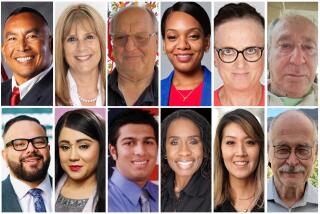RIFT OVER ARTS PANEL JOB AVERTED
- Share via
The potentially divisive battle over the chairmanship of the California Arts Council fizzled Friday in a show of conviviality.
Vice Chairman Harvey Stearn, an appointee of Gov. George Deukmejian, who had been waging a behind-the-scenes campaign to wrest the chairmanship from Stephen Goldstine, an appointee of former Gov. Edmund G. (Jerry) Brown Jr., instead nominated him.
“All of you know I’ve considered running for chairman,” Stearn acknowledged at the council’s first meeting of 1986, held at the Long Beach Convention Center. But, he said, the council must “re-evaluate and re-target” policies to achieve a “strong and stable” 1986-1987 budget in the face of the governor’s “flat budget.”
The $12.7 million for the CAC, including federal funding that Deukmejian is proposing for next year, is the same as the current budget.
“I feel the council must exemplify strong leadership and commonality,” Stearn said as he nominated Goldstine, whose one-year term will expire at the same time as his membership on the 11-member council. “I think Steve will do an excellent job; I want to be the first to nominate him. . . .”
Just before the lunch break, Stearn said privately: “I felt the election would have split the council. That would have been a problem for either of us. I thought the preservation of unity was more important” than personal victory.
Until Thursday, Stearn, vice president of the Mission Viejo Co., had been quietly campaigning against Goldstine, president of the San Francisco Art Institute. Although Goldstine reportedly had the support of another Deukmejian appointee, and Stearn might have had at least one Democratic appointee on his side, an election battle would have been viewed as a race between Republicans and Democrats in the ostensibly nonpartisan arts world.
After relaying the message to council director Bob Reid that he would not be running, Stearn told The Times that an election fight would be “too bitter” and “too divisive” and would split the vote “down the middle.”
With council member Bella Lewitzky absent, it appeared that the vote for chairman would have been 5-5.
Reid, who was appointed as council director by Deukmejian on Jan. 24 replacing Marilyn Ryan, had indicated that he did not want to take sides in the battle, particularly at a time when he had just taken over as director. He added that the governor “doesn’t want to get in the middle of these things” when he doesn’t have a majority of his own appointees on a council or commission.
Five of the council’s 11 members are Deukmejian appointees. Members are generally appointed to staggered four-year terms; nine are gubernatorial appointments; two are legislative.
Two weeks ago Deukmejian was expected to name a Latino to fill the vacancy created by the resignation of Ann Getty. Instead he named Joyce Pollock, president of a Sacramento real estate investment company that bears her name.
Immediately after his election, Goldstine endorsed Reid, the agency’s former chief deputy director, as “someone who cares about advancing the arts in California.”
Goldstine also welcomed Pollock, who serves on the board of the Crocker Art Museum Assn., as does Reid. “Joyce has made a difference in the growth of the (Crocker) art museum,” he said.
Goldstine said the two-point focus of the council’s 1986 agenda will involve its “mission” and the future of what he termed the “severly dislocated” role of arts education in California.
Speaking for the council’s multicultural program, Oscar Marciel, executive director of the Mission Cultural Center in San Francisco, said he “could not overstress” the need for his panel to have more than its proposed 1986-1987 $164,000 allotment.
June Gutfleisch, outgoing executive director of the California Confederation of the Arts, urged the council “to work with the confederation” and artists and arts organizations in the field “for a substantial augmentation” to the governor’s 1986-1987 budget for multicultural and other programs.
More to Read
The biggest entertainment stories
Get our big stories about Hollywood, film, television, music, arts, culture and more right in your inbox as soon as they publish.
You may occasionally receive promotional content from the Los Angeles Times.










